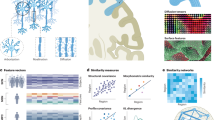Abstract
Many existing brain network distances are based on matrix norms. The element-wise differences may fail to capture underlying topological differences. Further, matrix norms are sensitive to outliers. A few extreme edge weights may severely affect the distance. Thus it is necessary to develop network distances that recognize topology. In this paper, we introduce Gromov-Hausdorff (GH) and Kolmogorov-Smirnov (KS) distances. GH-distance is often used in persistent homology based brain network models. The superior performance of KS-distance is contrasted against matrix norms and GH-distance in random network simulations with the ground truths. The KS-distance is then applied in characterizing the multimodal MRI and DTI study of maltreated children.
Access this chapter
Tax calculation will be finalised at checkout
Purchases are for personal use only
Similar content being viewed by others
References
Avants, B.B., Epstein, C.L., Grossman, M., Gee, J.C.: Symmetric diffeomorphic image registration with cross-correlation: evaluating automated labeling of elderly and neurodegenerative brain. Med. Image Anal. 12, 26–41 (2008)
Banks, D., Carley, K.: Metric inference for social networks. J. Classif. 11, 121–149 (1994)
Bonner, M.F., Grossman, M.: Gray matter density of auditory association cortex relates to knowledge of sound concepts in primary progressive aphasia. J. Neurosci. 32, 7986–7991 (2012)
Bullmore, E., Sporns, O.: Complex brain networks: graph theoretical analysis of structural and functional systems. Nat. Rev. Neurosci. 10, 186–98 (2009)
Carlsson, G., Mémoli, F.: Characterization, stability and convergence of hierarchical clustering methods. J. Mach. Learn. Res. 11, 1425–1470 (2010)
Chung, M.K.: Computational Neuroanatomy: The Methods. World Scientific, Singapore (2012)
Chung, M.K., Hanson, J.L., Ye, J., Davidson, R.J., Pollak, S.D.: Persistent homology in sparse regression and its application to brain morphometry. IEEE Trans. Med. Imaging 34, 1928–1939 (2015)
Chung, M.K., Villalta-Gil, V., Lee, H., Rathouz, P.J., Lahey, B.B., Zald, D.H.: Exact topological inference for paired brain networks via persistent homology. In: Niethammer, M., Styner, M., Aylward, S., Zhu, H., Oguz, I., Yap, P.-T., Shen, D. (eds.) IPMI 2017. LNCS, vol. 10265, pp. 299–310. Springer, Cham (2017). doi:10.1007/978-3-319-59050-9_24
Cook, P.A., Bai, Y., Nedjati-Gilani, S., Seunarine, K.K., Hall, M.G., Parker, G.J., Alexander, D.C.: Camino: open-source diffusion-MRI reconstruction and processing. In: 14th Scientific Meeting of the International Society for Magnetic Resonance in Medicine (2006)
Gibbons, J.D., Chakraborti, S.: Nonparametric Statistical Inference. Chapman & Hall/CRC Press, Boca Raton (2011)
He, Y., Chen, Z., Evans, A.: Structural insights into aberrant topological patterns of large-scale cortical networks in Alzheimer’s disease. J. Neurosci. 28, 4756 (2008)
Jezzard, P., Clare, S.: Sources of distortion in functional MRI data. Hum. Brain Mapp. 8, 80–85 (1999)
Joshi, S.C., Davis, B., Jomier, M., Gerig, G.: Unbiased diffeomorphic atlas construction for computational anatomy. NeuroImage 23, 151–160 (2004)
Lee, H., Kang, H., Chung, M.K., Kim, B.-N., Lee, D.S.: Persistent brain network homology from the perspective of dendrogram. IEEE Trans. Med. Imaging 31, 2267–2277 (2012)
Lee, H., Kang, H., Chung, M.K., Lim, S., Kim, B.-N., Lee, D.S.: Integrated multimodal network approach to PET and MRI based on multidimensional persistent homology. Hum. Brain Mapp. 38, 1387–1402 (2017)
Rubinov, M., Knock, S. A., Stam, C. J., Micheloyannis, S., Harris, A.W., Williams, L.M., Breakspear, M.: Small-world properties of nonlinear brain activity in schizophrenia
Rubinov, M., Sporns, O.: Complex network measures of brain connectivity: uses and interpretations. NeuroImage 52, 1059–1069 (2010)
Salvador, R., Suckling, J., Coleman, M.R., Pickard, J.D., Menon, D., Bullmore, E.: Neurophysiological architecture of functional magnetic resonance images of human brain. Cereb. Cortex 15, 1332–1342 (2005)
Tuzhilin, A.A.: Who invented the Gromov-Hausdorff distance? arXiv preprint arXiv:1612.00728 (2016)
Wijk, B.C.M., Stam, C.J., Daffertshofer, A.: Comparing brain networks of different size and connectivity density using graph theory. PLoS ONE 5, e13701 (2010)
Zhu, X., Suk, H.-I., Shen, D.: Matrix-similarity based loss function and feature selection for alzheimer’s disease diagnosis. In: Proceedings of the IEEE Conference on Computer Vision and Pattern Recognition, pp. 3089–3096 (2014)
Acknowledgements
This work is supported by NIH Grants MH61285, MH68858, MH84051, UL1TR000427, Brain Initiative Grant EB022856 and Basic Science Research Program through the National Research Foundation (NRF) of Korea (NRF-2016R1D1A1B03935463). M.K.C. would like to thank professor A.M. Mathai of McGill University for asking to prove the convergence of KS test in a homework. That homework motivated the construction of KS-distance for graphs.
Author information
Authors and Affiliations
Corresponding author
Editor information
Editors and Affiliations
Rights and permissions
Copyright information
© 2017 Springer International Publishing AG
About this paper
Cite this paper
Chung, M.K., Lee, H., Solo, V., Davidson, R.J., Pollak, S.D. (2017). Topological Distances Between Brain Networks. In: Wu, G., Laurienti, P., Bonilha, L., Munsell, B. (eds) Connectomics in NeuroImaging. CNI 2017. Lecture Notes in Computer Science(), vol 10511. Springer, Cham. https://doi.org/10.1007/978-3-319-67159-8_19
Download citation
DOI: https://doi.org/10.1007/978-3-319-67159-8_19
Published:
Publisher Name: Springer, Cham
Print ISBN: 978-3-319-67158-1
Online ISBN: 978-3-319-67159-8
eBook Packages: Computer ScienceComputer Science (R0)




